Tent Size
#51
Senior Member
Join Date: Dec 2019
Location: South Shore of Long Island
Posts: 2,799
Bikes: 2010 Carrera Volans, 2015 C-Dale Trail 2sl, 2017 Raleigh Rush Hour, 2017 Blue Proseccio, 1992 Giant Perigee, 80s Gitane Rallye Tandem
Mentioned: 12 Post(s)
Tagged: 0 Thread(s)
Quoted: 1088 Post(s)
Liked 1,025 Times
in
723 Posts
Smaller is better, there's less room for the wife to slide away  Our last camping trip the temps got into the low 30s, with a double wide r5 pad, a sheet on it for comfort, and both sleeping bags piled on like blankets it wasn't hard to stay warm even for her. I really don't know the truth on size mattering for temps but when camping off the Atlantic on a windy night with temps dipping into the 20s the 5 person tent didn't feel as cold waking up with me and 3 kids in it the same as the cabin tent in Montana on calm August nights even with it being all three kids, me and the wife. I've no problem believing it has no r-value, be hard to see how it would, but it also seems a tent would have less air movement and less surface area to speed up the transfer of heat vs a larger tent. I'd image a 2 vs 3 person tent might be more negligible, but my experience has been the larger the tent the colder is seems to get.
Our last camping trip the temps got into the low 30s, with a double wide r5 pad, a sheet on it for comfort, and both sleeping bags piled on like blankets it wasn't hard to stay warm even for her. I really don't know the truth on size mattering for temps but when camping off the Atlantic on a windy night with temps dipping into the 20s the 5 person tent didn't feel as cold waking up with me and 3 kids in it the same as the cabin tent in Montana on calm August nights even with it being all three kids, me and the wife. I've no problem believing it has no r-value, be hard to see how it would, but it also seems a tent would have less air movement and less surface area to speed up the transfer of heat vs a larger tent. I'd image a 2 vs 3 person tent might be more negligible, but my experience has been the larger the tent the colder is seems to get.
 Our last camping trip the temps got into the low 30s, with a double wide r5 pad, a sheet on it for comfort, and both sleeping bags piled on like blankets it wasn't hard to stay warm even for her. I really don't know the truth on size mattering for temps but when camping off the Atlantic on a windy night with temps dipping into the 20s the 5 person tent didn't feel as cold waking up with me and 3 kids in it the same as the cabin tent in Montana on calm August nights even with it being all three kids, me and the wife. I've no problem believing it has no r-value, be hard to see how it would, but it also seems a tent would have less air movement and less surface area to speed up the transfer of heat vs a larger tent. I'd image a 2 vs 3 person tent might be more negligible, but my experience has been the larger the tent the colder is seems to get.
Our last camping trip the temps got into the low 30s, with a double wide r5 pad, a sheet on it for comfort, and both sleeping bags piled on like blankets it wasn't hard to stay warm even for her. I really don't know the truth on size mattering for temps but when camping off the Atlantic on a windy night with temps dipping into the 20s the 5 person tent didn't feel as cold waking up with me and 3 kids in it the same as the cabin tent in Montana on calm August nights even with it being all three kids, me and the wife. I've no problem believing it has no r-value, be hard to see how it would, but it also seems a tent would have less air movement and less surface area to speed up the transfer of heat vs a larger tent. I'd image a 2 vs 3 person tent might be more negligible, but my experience has been the larger the tent the colder is seems to get.
#52
bicycle tourist
When I see someone from Colorado talking with someone from Missouri about condensation, I wonder what assumptions are being made about the dew point and related average humidity.
For example, here is a dew point map I just pulled.
Now it is exceptionally dry in middle of the country right now (causing red flag fire warnings where there are high winds).

However even the normal April dew points are less west of the 100th meridian than east of it.
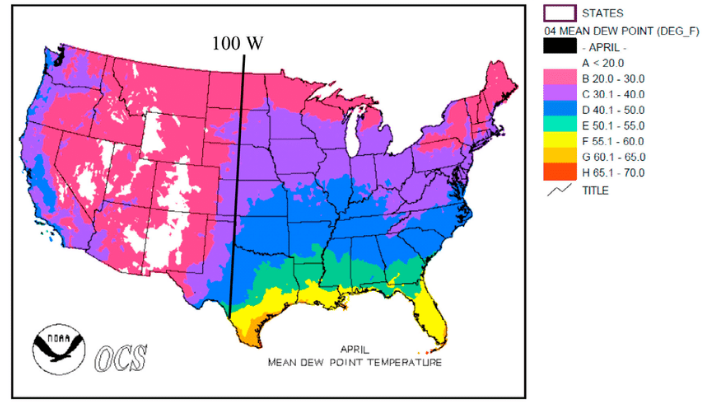
So my experiences camping in the US west - I tend to agree that condensation has not been that big of a deal or consideration and typically having those gaps between fly and the inner tent is more than enough to deal with it. Some experience camping east of the 100th meridian and it has been more hit/miss depending on the actual humidity and dew points I am experiencing when camping.
For example, here is a dew point map I just pulled.
Now it is exceptionally dry in middle of the country right now (causing red flag fire warnings where there are high winds).

However even the normal April dew points are less west of the 100th meridian than east of it.

So my experiences camping in the US west - I tend to agree that condensation has not been that big of a deal or consideration and typically having those gaps between fly and the inner tent is more than enough to deal with it. Some experience camping east of the 100th meridian and it has been more hit/miss depending on the actual humidity and dew points I am experiencing when camping.
#53
Senior Member
Join Date: Aug 2010
Location: Madison, WI
Posts: 11,209
Bikes: 1961 Ideor, 1966 Perfekt 3 Speed AB Hub, 1994 Bridgestone MB-6, 2006 Airnimal Joey, 2009 Thorn Sherpa, 2013 Thorn Nomad MkII, 2015 VO Pass Hunter, 2017 Lynskey Backroad, 2017 Raleigh Gran Prix, 1980s Bianchi Mixte on a trainer. Others are now gone.
Mentioned: 48 Post(s)
Tagged: 0 Thread(s)
Quoted: 3461 Post(s)
Liked 1,467 Times
in
1,144 Posts
Condensation in a tent can be problematic if your tent is small enough that you are frequently touching the inside of the rain fly.
The tent in the photo below, I bought that about seven years ago, a single wall tent, the roof and ceiling are one sheet of silicone impregnated nylon. The tent is rated for two people based on floor size, but I think it would be a disaster with two, you would constantly be rubbing on the ceiling if you were on one side of the tent. But, for solo use, I find it works great because it is light weight and I can stay in the center of the tent, there I can avoid touching the condensation coated ceiling.
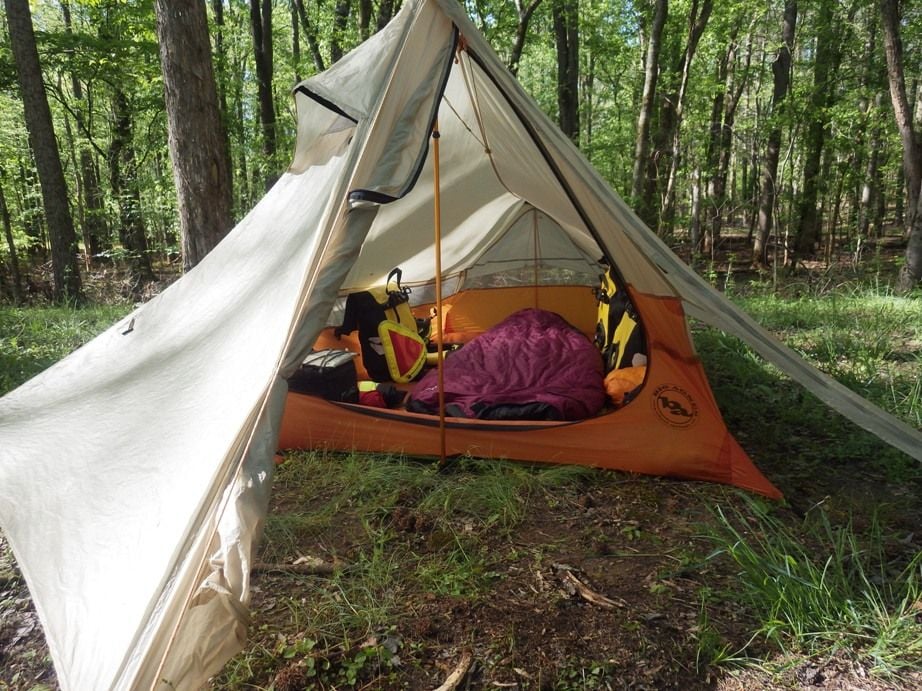
It is tall enough near the door that I can sit upright and not be pressing on the ceiling. Same tent below. I think this tent is no longer in production.
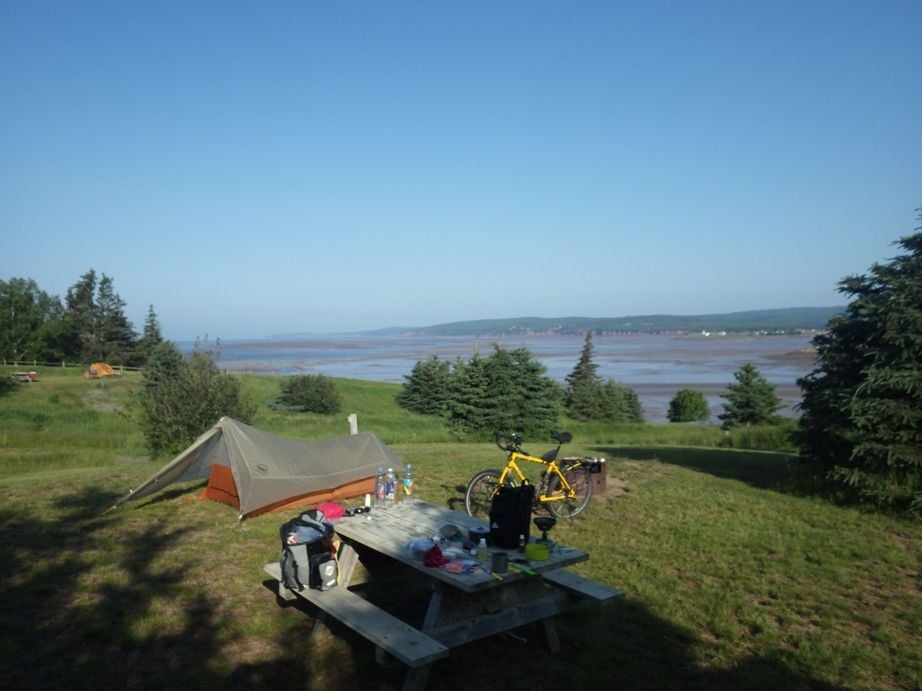
The tent below is my tiny tent for backpacking, that tent is small enough that I am constantly touching the ceiling, so I am happy to have a netting inner tent that when I touch that, it informs my brain that I will get wet if I push a few inches further.
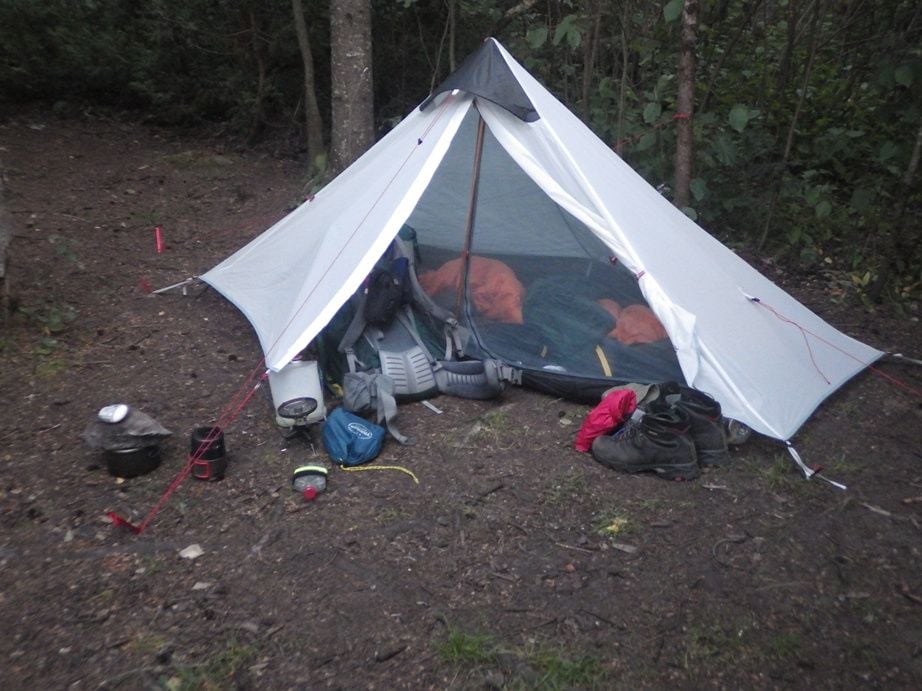
The tent in the photo below, I bought that about seven years ago, a single wall tent, the roof and ceiling are one sheet of silicone impregnated nylon. The tent is rated for two people based on floor size, but I think it would be a disaster with two, you would constantly be rubbing on the ceiling if you were on one side of the tent. But, for solo use, I find it works great because it is light weight and I can stay in the center of the tent, there I can avoid touching the condensation coated ceiling.

It is tall enough near the door that I can sit upright and not be pressing on the ceiling. Same tent below. I think this tent is no longer in production.

The tent below is my tiny tent for backpacking, that tent is small enough that I am constantly touching the ceiling, so I am happy to have a netting inner tent that when I touch that, it informs my brain that I will get wet if I push a few inches further.

#54
Senior Member
My experience was that 1 and 2 person tents were about the same temp in cold weather, as they are very well ventilated (lots of mesh area under the fly cover) to not accumulate condensation, if not a winter tent. If your body is heating up the tent, your sleeping bag is not doing its job. Since a 2 person tent was only marginally heavier than a 1 person (poles about the same, only a bit less fabric) but half the space, I went 2 person, it gives me space to keep gear out of the rain if needed. That might be different if I backpacked now, because I bring hiking poles and they have non-freestanding tents that can use those instead of tent poles, so the tent might be a lot less weight, but this doesn't apply to bike camping. These days I ride a folder so would definitely bring a 2-person tent, fold the bike, put inside overnight to prevent theft.
When I toured with a long-wheelbase recumbent with trailer (tons of room in a giant rubbermaid box, I didn't even need to compress and stuff the down sleeping bag), I had two rectangular down bags that I used to zip together when camping dual, and if colder weather, I would either bring both of those and put one inside the other for warmth if needed (very versatile, wide temp comfort), or bring one bag and a fleece bag that could go inside the down for warmth and as a liner. If not, I always brought a silk liner to keep the bag clean. When camping on a beach with large flat rocks near a major city (cold, no mosquitos so no tent), I used the black fleece bag on the outside of the down bag, both to protect the lightweight nylon fabric, and as night camouflage to keep from being spotted (black, and non-reflective).
When I toured with a long-wheelbase recumbent with trailer (tons of room in a giant rubbermaid box, I didn't even need to compress and stuff the down sleeping bag), I had two rectangular down bags that I used to zip together when camping dual, and if colder weather, I would either bring both of those and put one inside the other for warmth if needed (very versatile, wide temp comfort), or bring one bag and a fleece bag that could go inside the down for warmth and as a liner. If not, I always brought a silk liner to keep the bag clean. When camping on a beach with large flat rocks near a major city (cold, no mosquitos so no tent), I used the black fleece bag on the outside of the down bag, both to protect the lightweight nylon fabric, and as night camouflage to keep from being spotted (black, and non-reflective).
Last edited by Duragrouch; 04-08-24 at 11:12 PM.
#55
Mad bike riding scientist
Join Date: Nov 2004
Location: Denver, CO
Posts: 27,366
Bikes: Some silver ones, a red one, a black and orange one, and a few titanium ones
Mentioned: 152 Post(s)
Tagged: 1 Thread(s)
Quoted: 6219 Post(s)
Liked 4,220 Times
in
2,367 Posts
Condensation is the conversion of a gas to a liquid. To bring this tangent back to the original topic, if you close up your tent to try to seal in the warmth, you will cause water to condense inside the tent. If there is a significant amount of condensation, it will run down the walls of the tent, and much of it will find its way into your sleeping bag. Whether or not we agree on the physics, it's a thing that actually happens (though probably not much at 40°F).
My experience was that 1 and 2 person tents were about the same temp in cold weather, as they are very well ventilated (lots of mesh area under the fly cover) to not accumulate condensation, if not a winter tent. If your body is heating up the tent, your sleeping bag is not doing its job.
 . But with each breath, you are releasing heat into the tent. Your breath has to heat a larger volume with a larger tent.
. But with each breath, you are releasing heat into the tent. Your breath has to heat a larger volume with a larger tent.
__________________
Stuart Black
Plan Epsilon Around Lake Michigan in the era of Covid
Old School…When It Wasn’t Ancient bikepacking
Gold Fever Three days of dirt in Colorado
Pokin' around the Poconos A cold ride around Lake Erie
Dinosaurs in Colorado A mountain bike guide to the Purgatory Canyon dinosaur trackway
Solo Without Pie. The search for pie in the Midwest.
Picking the Scablands. Washington and Oregon, 2005. Pie and spiders on the Columbia River!
Stuart Black
Plan Epsilon Around Lake Michigan in the era of Covid
Old School…When It Wasn’t Ancient bikepacking
Gold Fever Three days of dirt in Colorado
Pokin' around the Poconos A cold ride around Lake Erie
Dinosaurs in Colorado A mountain bike guide to the Purgatory Canyon dinosaur trackway
Solo Without Pie. The search for pie in the Midwest.
Picking the Scablands. Washington and Oregon, 2005. Pie and spiders on the Columbia River!
#56
Mad bike riding scientist
Join Date: Nov 2004
Location: Denver, CO
Posts: 27,366
Bikes: Some silver ones, a red one, a black and orange one, and a few titanium ones
Mentioned: 152 Post(s)
Tagged: 1 Thread(s)
Quoted: 6219 Post(s)
Liked 4,220 Times
in
2,367 Posts
On the other hand, I am also far more likely to run across conditions where being in cold weather even in the height of summer and where tent warmth can be an issue...as I've experienced first hand.
__________________
Stuart Black
Plan Epsilon Around Lake Michigan in the era of Covid
Old School…When It Wasn’t Ancient bikepacking
Gold Fever Three days of dirt in Colorado
Pokin' around the Poconos A cold ride around Lake Erie
Dinosaurs in Colorado A mountain bike guide to the Purgatory Canyon dinosaur trackway
Solo Without Pie. The search for pie in the Midwest.
Picking the Scablands. Washington and Oregon, 2005. Pie and spiders on the Columbia River!
Stuart Black
Plan Epsilon Around Lake Michigan in the era of Covid
Old School…When It Wasn’t Ancient bikepacking
Gold Fever Three days of dirt in Colorado
Pokin' around the Poconos A cold ride around Lake Erie
Dinosaurs in Colorado A mountain bike guide to the Purgatory Canyon dinosaur trackway
Solo Without Pie. The search for pie in the Midwest.
Picking the Scablands. Washington and Oregon, 2005. Pie and spiders on the Columbia River!
#57
aka Timi
Common wisdom, as I’ve come to understand it, is that if you’re cold, you shouldn’t close your sleeping bag over your head as your breath condenses and you’ll get even colder. However, in my long experience of freezing at night (believe me I am very experienced), this ain’t the way it works. I’m definitely warmer inside, rather than freezing my face off through a little opening.
What say ye, condensation experts?
edit to add: Unless it’s raining heavily, I always sleep under the stars, so that may be a factor to consider. Oh and have only synthetic bags.
What say ye, condensation experts?
edit to add: Unless it’s raining heavily, I always sleep under the stars, so that may be a factor to consider. Oh and have only synthetic bags.
Last edited by imi; 04-08-24 at 12:40 PM.
#58
Senior Member
Join Date: Aug 2010
Location: Madison, WI
Posts: 11,209
Bikes: 1961 Ideor, 1966 Perfekt 3 Speed AB Hub, 1994 Bridgestone MB-6, 2006 Airnimal Joey, 2009 Thorn Sherpa, 2013 Thorn Nomad MkII, 2015 VO Pass Hunter, 2017 Lynskey Backroad, 2017 Raleigh Gran Prix, 1980s Bianchi Mixte on a trainer. Others are now gone.
Mentioned: 48 Post(s)
Tagged: 0 Thread(s)
Quoted: 3461 Post(s)
Liked 1,467 Times
in
1,144 Posts
Common wisdom, as I’ve come to understand it, is that if you’re cold, you shouldn’t close your sleeping bag over your head as your breath condenses and you’ll get even colder. However, in my long experience of freezing at night (believe me I am very experienced), this ain’t the way it works. I’m definitely warmer inside, rather than freezing my face off through a little opening.
What say ye, condensation experts?
edit to add: Unless it’s raining heavily, I always sleep under the stars, so that may be a factor to consider. Oh and have only synthetic bags.
What say ye, condensation experts?
edit to add: Unless it’s raining heavily, I always sleep under the stars, so that may be a factor to consider. Oh and have only synthetic bags.
I first noticed this on a week long snowshoeing trip with two friends several decades ago. Temperatures ranged from the minus 10 to plus 25 degrees (F) range [or minus 23 to minus 4 (C)]. I had a down bag that performed well. But we stopped on the way home to visit family of one of the group, and for that we slept indoors. Thus, after sleeping in our down bags for a week in sub freezing temperatures, when we brought our bags indoors and slept inside in warm conditions, all of us were shocked how much moisture our bags had accumulated.
Years ago I read the book written by Will Steger and Paul Schurke on their trip to the north pole by dog sled, I do not recall how many people in the group, maybe four or six? I recall that their synthetic sleeping bags got quite heavy from accumulated moisture weight. I was surprised that if they had used vapor barrier liners, they did not work or maybe they just did not use them? But the very heavy sleeping bags later during the trip was a logistics problem for them.
In sub freezing conditions, that moisture in your sleeping bag insulation will be ice crystals, sublimation will be very slow and you will just accumulate more and more moisture during the trip as long as it stays below freezing.
If you want to exhale inside your bag in cold conditions, that is your call. I do not do that.
#59
aka Timi
Sorry, I maybe should have been clearer. I wasn’t thinking of multi day sub-freezing conditions, rather the few degrees colder than usual night, so maybe 0 to +5 C
Last edited by imi; 04-08-24 at 03:22 PM.
#60
Senior Member
Yes, and that might matter in a winter tent. But in a 3-season tent with a lot of ventilation, especially big mesh panels directly overhead under the fly (the heat goes straight up), the rate of air exchange with the outside makes breath warming, or from any other source, a lost cause. Especially with a tent like mine, without a full coverage fly, it's propped up front and back, great ventilation in the summer, but cold if the weather is cold, blows any hot air right out. I tried a similar tent with full-coverage fly down to the ground to have front and rear vestibles, it was terribly hot and humid on the one warm night I used it, even with the vestibules zipped open, I immediately returned it. But that would have been a better winter tent.
#61
Senior Member
Common wisdom, as I’ve come to understand it, is that if you’re cold, you shouldn’t close your sleeping bag over your head as your breath condenses and you’ll get even colder. However, in my long experience of freezing at night (believe me I am very experienced), this ain’t the way it works. I’m definitely warmer inside, rather than freezing my face off through a little opening.
What say ye, condensation experts?
edit to add: Unless it’s raining heavily, I always sleep under the stars, so that may be a factor to consider. Oh and have only synthetic bags.
What say ye, condensation experts?
edit to add: Unless it’s raining heavily, I always sleep under the stars, so that may be a factor to consider. Oh and have only synthetic bags.
I avoid breathing in mysleeping bag or bivy if using one. I generally try very hard to avoid moisture in the bag. This includes sweat. That means not bundling up until it is cold. So I tend to progressively go warmer. Starting out not in the bag then draping it over myself, then zipping it partially, then fully, then pulling the drawstring and breathing through the little hole. I find that avoids getting sweaty in the early hours and then being cold later.
I tend to manage to stay warm with much less insulation than those around me. I don't know for sure, but suspect that one factor might be that they bundle up early and get enough sweat in their bag to be cold later. Then again I might just put out heat like a furnace.
#62
aka Timi
I think people‘s sleep metabolisms are simply different, not that they‘ve necessarily already sweated in their bags.
Last edited by imi; 04-09-24 at 05:47 AM.
#63
Mad bike riding scientist
Join Date: Nov 2004
Location: Denver, CO
Posts: 27,366
Bikes: Some silver ones, a red one, a black and orange one, and a few titanium ones
Mentioned: 152 Post(s)
Tagged: 1 Thread(s)
Quoted: 6219 Post(s)
Liked 4,220 Times
in
2,367 Posts
Common wisdom, as I’ve come to understand it, is that if you’re cold, you shouldn’t close your sleeping bag over your head as your breath condenses and you’ll get even colder. However, in my long experience of freezing at night (believe me I am very experienced), this ain’t the way it works. I’m definitely warmer inside, rather than freezing my face off through a little opening.
What say ye, condensation experts?
edit to add: Unless it’s raining heavily, I always sleep under the stars, so that may be a factor to consider. Oh and have only synthetic bags.
What say ye, condensation experts?
edit to add: Unless it’s raining heavily, I always sleep under the stars, so that may be a factor to consider. Oh and have only synthetic bags.
We are also talking about a tiny amount if water when it does condense. Eight hours of breathing releases 150 mL of water. Not all of that is going to condense nor be absorbed by the bag even if you are breathing into it. A significant amount remains as water vapor. How much remains as water vapor is going to depend on the temperature and humidity of the air around and in the tent. I would expect to see much more condensation in the cold mountain conditions I encounter here in Colorado because the temperature differential is greater and the dew point is lower. Our higher altitude can't carry as much water as air down where it is thicker. If I start a night at about 60°F and the temperature drops to 30°F (a common event), the air can't carry the moisture load as well. I camped a lot in other parts of the country where the humidity is higher and I've never noticed that kind of temperature differential.
__________________
Stuart Black
Plan Epsilon Around Lake Michigan in the era of Covid
Old School…When It Wasn’t Ancient bikepacking
Gold Fever Three days of dirt in Colorado
Pokin' around the Poconos A cold ride around Lake Erie
Dinosaurs in Colorado A mountain bike guide to the Purgatory Canyon dinosaur trackway
Solo Without Pie. The search for pie in the Midwest.
Picking the Scablands. Washington and Oregon, 2005. Pie and spiders on the Columbia River!
Stuart Black
Plan Epsilon Around Lake Michigan in the era of Covid
Old School…When It Wasn’t Ancient bikepacking
Gold Fever Three days of dirt in Colorado
Pokin' around the Poconos A cold ride around Lake Erie
Dinosaurs in Colorado A mountain bike guide to the Purgatory Canyon dinosaur trackway
Solo Without Pie. The search for pie in the Midwest.
Picking the Scablands. Washington and Oregon, 2005. Pie and spiders on the Columbia River!
#64
Mad bike riding scientist
Join Date: Nov 2004
Location: Denver, CO
Posts: 27,366
Bikes: Some silver ones, a red one, a black and orange one, and a few titanium ones
Mentioned: 152 Post(s)
Tagged: 1 Thread(s)
Quoted: 6219 Post(s)
Liked 4,220 Times
in
2,367 Posts
Yes, and that might matter in a winter tent. But in a 3-season tent with a lot of ventilation, especially big mesh panels directly overhead under the fly (the heat goes straight up), the rate of air exchange with the outside makes breath warming, or from any other source, a lost cause. Especially with a tent like mine, without a full coverage fly, it's propped up front and back, great ventilation in the summer, but cold if the weather is cold, blows any hot air right out. I tried a similar tent with full-coverage fly down to the ground to have front and rear vestibles, it was terribly hot and humid on the one warm night I used it, even with the vestibules zipped open, I immediately returned it. But that would have been a better winter tent.
__________________
Stuart Black
Plan Epsilon Around Lake Michigan in the era of Covid
Old School…When It Wasn’t Ancient bikepacking
Gold Fever Three days of dirt in Colorado
Pokin' around the Poconos A cold ride around Lake Erie
Dinosaurs in Colorado A mountain bike guide to the Purgatory Canyon dinosaur trackway
Solo Without Pie. The search for pie in the Midwest.
Picking the Scablands. Washington and Oregon, 2005. Pie and spiders on the Columbia River!
Stuart Black
Plan Epsilon Around Lake Michigan in the era of Covid
Old School…When It Wasn’t Ancient bikepacking
Gold Fever Three days of dirt in Colorado
Pokin' around the Poconos A cold ride around Lake Erie
Dinosaurs in Colorado A mountain bike guide to the Purgatory Canyon dinosaur trackway
Solo Without Pie. The search for pie in the Midwest.
Picking the Scablands. Washington and Oregon, 2005. Pie and spiders on the Columbia River!
#65
Senior Member
Join Date: Apr 2019
Location: Central Illinois
Posts: 552
Bikes: 1985 Cannondale SR500, 1990 Cannondale ST600, 1993 Cannondale M700
Mentioned: 4 Post(s)
Tagged: 0 Thread(s)
Quoted: 171 Post(s)
Liked 278 Times
in
108 Posts
I prefer a 1 person tent.
The Hilleberg Akto is my favorite.
https://hilleberg.com/eng/tent/solo-tents/
Years ago I had a Kelty Windfoil Ultralight that was a great, inexpensive, single person tent. It’s not made anymore, but Snugpak makes one now that is the same design, and is inexpensive also. It looks pretty great too!
https://snugpakusa.com/product.php?id=76
The Hilleberg Akto is my favorite.
https://hilleberg.com/eng/tent/solo-tents/
Years ago I had a Kelty Windfoil Ultralight that was a great, inexpensive, single person tent. It’s not made anymore, but Snugpak makes one now that is the same design, and is inexpensive also. It looks pretty great too!
https://snugpakusa.com/product.php?id=76
Last edited by riverdrifter; 04-09-24 at 10:11 AM.
#66
bicycle tourist
Higher altitude = *more* condensation (less ability to hold moisture)
Lower temperature = condensation (getting closer to the dew point)
I expect a high diurnal temperature range to be correlated with lower humidity/dew points but not quite the same. For example, following is a diurnal range map for March followed by an average dew point map:
So to compare two different areas of the map: a lot of New Mexico vs say middle of Florida...
- On average New Mexico will have a larger day/night swing but also lower overall humidity as represented by the dew points.
- On average middle of Florida will have a lower day/night swing but also relatively speaking higher humidity and dew points.
So I expect the condensation in Florida to happen with higher overnight temperatures than in New Mexico - but the chance of lower overnight temperatures is much more in New Mexico.
In practice what this has meant in my touring has been (a) I've tended to carry a heavier sleeping bag and worry more about cold in New Mexico since I see the overnight temperatures (b) I've noticed dew & condensation as well as keeping my tent ventilated and packing a wet tent more in Florida.
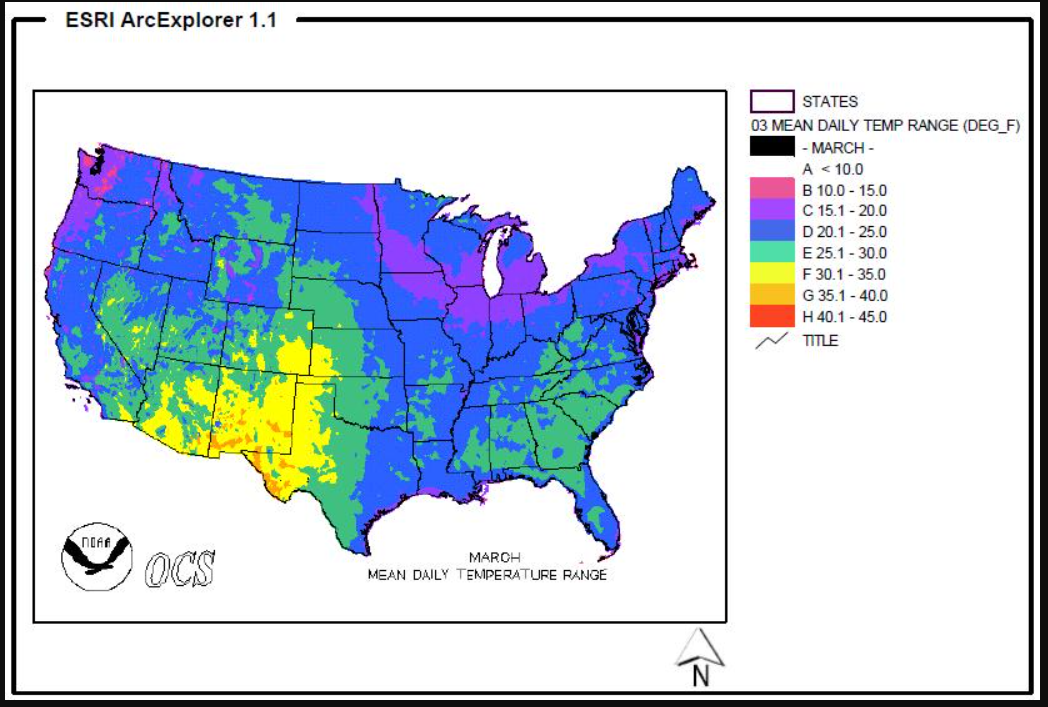
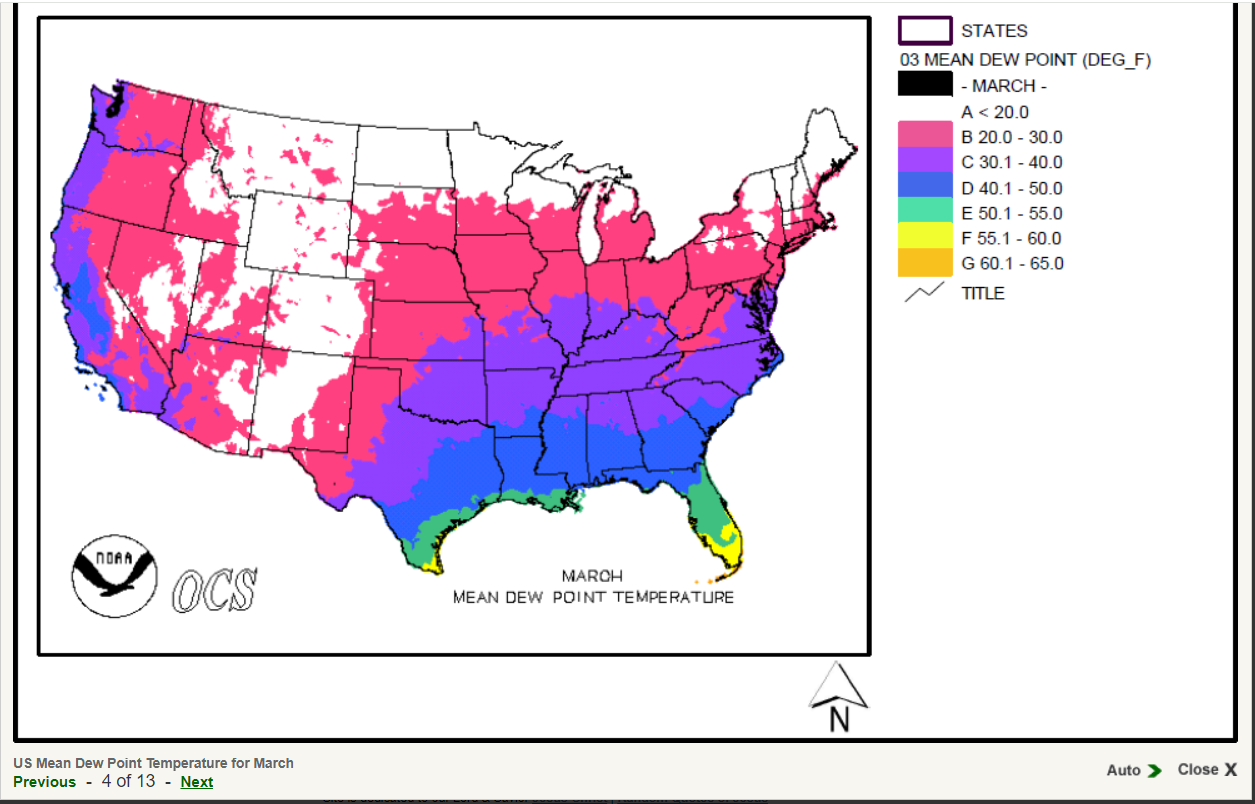
Last edited by mev; 04-09-24 at 03:26 PM.
#67
Junior Member
Join Date: Oct 2021
Location: Northern Virginia
Posts: 111
Bikes: Motobecane Grand Record, Motobecane Super Mirage (3x5 speeds), Motobecane Mirage, Atala (unknown model), Peugeot mixte frame Tourist and Schwinn Sport. A bunch more kids bikes. Most recently a Trek Verve One, tricked up for serious touring.
Mentioned: 1 Post(s)
Tagged: 0 Thread(s)
Quoted: 40 Post(s)
Liked 45 Times
in
29 Posts
Common wisdom, as I’ve come to understand it, is that if you’re cold, you shouldn’t close your sleeping bag over your head as your breath condenses and you’ll get even colder. However, in my long experience of freezing at night (believe me I am very experienced), this ain’t the way it works. I’m definitely warmer inside, rather than freezing my face off through a little opening.
What say ye, condensation experts?
edit to add: Unless it’s raining heavily, I always sleep under the stars, so that may be a factor to consider. Oh and have only synthetic bags.
What say ye, condensation experts?
edit to add: Unless it’s raining heavily, I always sleep under the stars, so that may be a factor to consider. Oh and have only synthetic bags.
Likes For sbrudno:
#68
Senior Member
Yes, the heat goes up but it is then trapped in the envelop of the rain fly. It doesn't get swept out immediately or even quickly. I've slept many nights with the door open only to have to close it in the middle of the night. The temperature difference is immediately noticable. I've also started the night without a fly at around 10,000 feet only to have to get up in the middle of the night to put the fly on. Again, the results are immediate. Trapping the air (and heat) from your breath helps.
Last edited by Duragrouch; 04-09-24 at 06:22 PM.
#69
Senior Member
Thread Starter
Thanks for all of the feedback. I bought a Coleman 2 man tent for my Adventure Cycling Association Big Bend National Park bike tour. It was the wrong tent. Because of the wind and rocky terrain it took 2 or more people to set the tent up and take down. The tent was like a sail on a ship catching the wind at every breeze and gust. I expended too much energy setting up and taking down this tent. I should've bought a free-standing tent that was easier to use. This was my first (maybe last) bike tour and I did not know what I was doing. The route was extremely mountainous and I ride where it is flat. I made most of the 365 miles on the bike but rode in the van several times over some climbs.
#70
Senior Member
(above) Yeah I really like freestanding tents for exactly that reason, even most of the fly points go to the same pole ends, just the middle of the fly sides needing guying out with a line and rock if on hard surface. 2-pole rectangular dome tents (mine has a short 3rd pole for the middle of the fly), simple and fast to set up and take down, especially with clips for the poles instead of long sleeves. They won't do mountaineering winds or snow loads, but can withstand gust of maybe up to 20 mph (pure guess) when oriented the narrower side to the wind. Mine is either 4' or 4'6" tall, can't remember, enough space and less wind-vulnerable, and lighter.
I'd love to go with one of those super-light all-fabric tents or lean-tos that use hiking poles, but a lot trickier to set up without stakes in ground.
I'd love to go with one of those super-light all-fabric tents or lean-tos that use hiking poles, but a lot trickier to set up without stakes in ground.
Last edited by Duragrouch; 04-11-24 at 09:29 PM.
#71
Senior Member
Join Date: Aug 2010
Location: Madison, WI
Posts: 11,209
Bikes: 1961 Ideor, 1966 Perfekt 3 Speed AB Hub, 1994 Bridgestone MB-6, 2006 Airnimal Joey, 2009 Thorn Sherpa, 2013 Thorn Nomad MkII, 2015 VO Pass Hunter, 2017 Lynskey Backroad, 2017 Raleigh Gran Prix, 1980s Bianchi Mixte on a trainer. Others are now gone.
Mentioned: 48 Post(s)
Tagged: 0 Thread(s)
Quoted: 3461 Post(s)
Liked 1,467 Times
in
1,144 Posts
Thanks for all of the feedback. I bought a Coleman 2 man tent for my Adventure Cycling Association Big Bend National Park bike tour. It was the wrong tent. Because of the wind and rocky terrain it took 2 or more people to set the tent up and take down. The tent was like a sail on a ship catching the wind at every breeze and gust. I expended too much energy setting up and taking down this tent. I should've bought a free-standing tent that was easier to use. This was my first (maybe last) bike tour and I did not know what I was doing. The route was extremely mountainous and I ride where it is flat. I made most of the 365 miles on the bike but rode in the van several times over some climbs.
I did that trip with ACA, van supported camping in 2018. Agree on the rocky hard ground, but apparently we had better weather regarding wind, I never had trouble setting up my non-self supporting tent. The wind was so bad one morning that a few brave souls tried biking, the rest of us rode in the van. And a few miles after the start we picked up the riders that tried to ride into the headwind, then everyone rode in the van that day.

I do not have a photo of my tent on that trip, but here are some of the others, this was hard ground.
Photo below, this morning was below freezing. I left my water bottles on the bike overnight, there was ice in them in the morning.
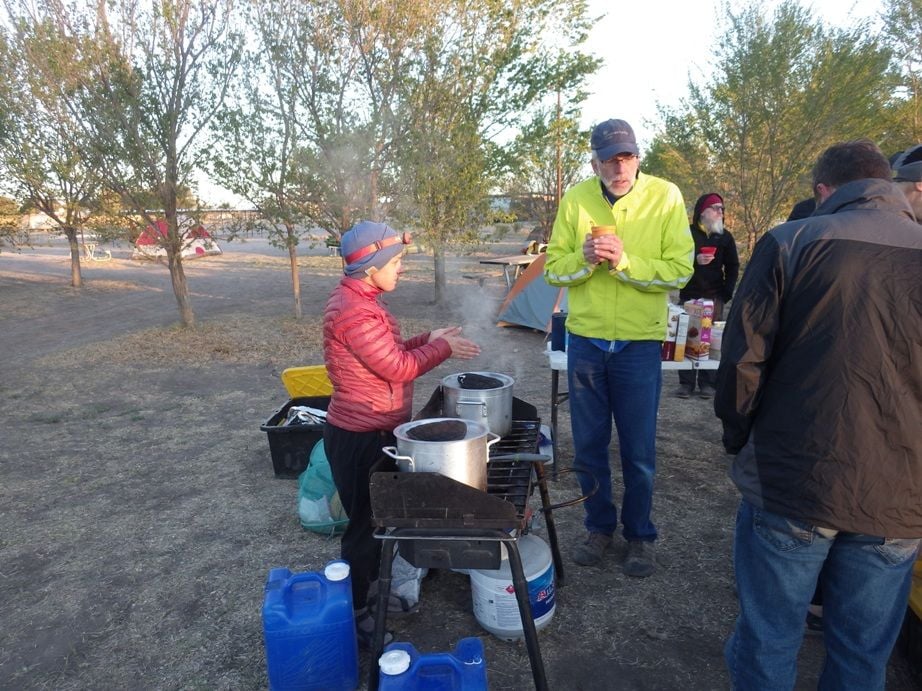
#72
Senior Member
Thread Starter
Bummer.
I did that trip with ACA, van supported camping in 2018. Agree on the rocky hard ground, but apparently we had better weather regarding wind, I never had trouble setting up my non-self supporting tent. The wind was so bad one morning that a few brave souls tried biking, the rest of us rode in the van. And a few miles after the start we picked up the riders that tried to ride into the headwind, then everyone rode in the van that day.

I do not have a photo of my tent on that trip, but here are some of the others, this was hard ground.
Photo below, this morning was below freezing. I left my water bottles on the bike overnight, there was ice in them in the morning.

I did that trip with ACA, van supported camping in 2018. Agree on the rocky hard ground, but apparently we had better weather regarding wind, I never had trouble setting up my non-self supporting tent. The wind was so bad one morning that a few brave souls tried biking, the rest of us rode in the van. And a few miles after the start we picked up the riders that tried to ride into the headwind, then everyone rode in the van that day.

I do not have a photo of my tent on that trip, but here are some of the others, this was hard ground.
Photo below, this morning was below freezing. I left my water bottles on the bike overnight, there was ice in them in the morning.

Link to my blog post for day one https://www.texbiker.net/blog/2024/0...hon-3-31-2024/
#73
Senior Member
#74
Senior Member
Join Date: Aug 2005
Posts: 3,872
Mentioned: 14 Post(s)
Tagged: 0 Thread(s)
Quoted: 598 Post(s)
Liked 283 Times
in
194 Posts
Very sorry things didn't go quite as planned but don't give up on touring just yet. Give it another shot in terrain you're more familiar with, and yes, a free standing tent is worth its weight in gold under certain conditions.
My first tour was miserable because I didn't know what the hell I was doing as there was no internet and experienced advice but the 2nd time went much smoother and the third better yet.
My first tour was miserable because I didn't know what the hell I was doing as there was no internet and experienced advice but the 2nd time went much smoother and the third better yet.
Likes For robow:










